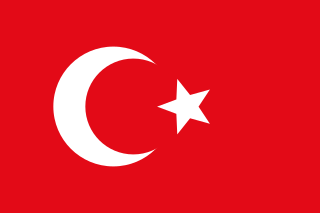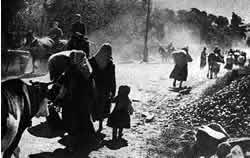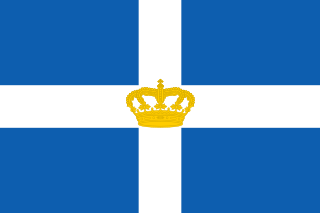 W
WThe Battle of Kovanbaşı was a battle between Turkish National Forces and the French Third Republic during the Franco-Turkish War. The battle ended with a Turkish victory on 11 October 1920.
 W
WThe Franco–Turkish War, known as the Cilicia Campaign in France and as the Southern Front of the Turkish War of Independence in Turkey, was a series of conflicts fought between France and the Turkish National Forces from December 1918 to October 1921 in the aftermath of World War I. French interest in the region resulted from the Sykes-Picot Agreement and returning Armenian refugees of the Armenian Genocide back to their homes.
 W
WThe Government of the Grand National Assembly, commonly known as the Ankara Government, was the name given to the provisional and revolutionary Turkish government based in Ankara during the Turkish War of Independence (1919–1923) and during the final years of the Ottoman Empire. It was led by the Turkish National Movement, as opposed to the crumbling Constantinople Government, which was led by the Ottoman Sultan.
 W
WThe Greco-Turkish War of 1919–1922 was fought between Greece and the Turkish National Movement during the partitioning of the Ottoman Empire in the aftermath of World War I, between May 1919 and October 1922.
 W
WThe Greek Summer Offensive of 1920 was an offensive by the Greek army, assisted by British forces, to capture the southern region of the Sea of Marmara and the Aegean Region from the Kuva-yi Milliye of the provisional Turkish national movement government in Ankara. Additionally, the Greek and British forces were supported by the Kuva-yi Inzibatiye of the Ottoman government in Constantinople, which sought to crush the Turkish nationalist forces. The offensive was part of the Greco-Turkish War and was one of several engagements where British troops assisted the advancing Greek army. British troops actively took part in invading coastal towns of the Sea of Marmara. With the approval of the Allies, the Greeks started their offensive on 22 June 1920 and crossed the 'Milne Line'. The 'Milne Line' was the demarcation line between Greece and Turkey, laid down in Paris. Resistance by the Turks was limited, as they had few and ill-equipped troops in western Anatolia. They were also busy on the eastern and southern fronts. After offering some opposition, they retreated to Eskişehir on Mustafa Kemal Pasha's order.
 W
WThe İzmit massacres refer to atrocities committed in the region of İzmit, Turkey, during the Greco-Turkish War (1919-1922) which took place during the Greek Genocide. An Inter-Allied Commission of Enquiry that investigated the incidents, submitted a report, on 1 June 1921, about the events. In general it accepted the Greek claims that Turkish troops massacred more than 12,000 local civilians, while 2,500 were missing and stated that the atrocities committed by the Turks in the Izmit peninsula "have been more considerable and ferocious than those on the part of the Greeks".
 W
WThe Battle of Kanlı Geçit was a battle between Turkish National Forces and the French Third Republic during the Franco-Turkish War. The battle ended with a Turkish victory on November 1, 1920.
 W
WThe Battle of Kars was the largest battle of the Turkish-Armenian War. The battle was between the Turkish Revolutionaries operating under the command of the newly formed Grand National Assembly of Turkey (TBMM) and the Democratic Republic of Armenia. After launching a massive assault on the city, the Turkish Army re-captured the city of Kars after losing it just a few months before. The whole battle took place on 20 October 1920.
 W
WThe Kuvâ-i İnzibâtiyye was an army established on 18 April 1920 by the imperial government of the Ottoman Empire in order to fight against the Turkish National Movement in the aftermath of World War I. It was commanded by Süleyman Şefik Pasha.
 W
WMisak-ı Millî is the set of six decisions made by the last term of the Ottoman Parliament. Parliament met on 28 January 1920 and published their decisions on 12 February 1920.
 W
WThe occupation of Constantinople, the capital of the Ottoman Empire, by British, French, Italian, Greek forces, took place in accordance with the Armistice of Mudros, which ended Ottoman participation in the First World War. The first French troops entered the city on November 12, 1918, followed by British troops the next day. The Italian troops landed in Galata on February 7, 1919.
 W
WThe occupation of Smyrna was the military control by Greek forces of the city of Smyrna and surrounding areas from 15 May 1919 until 9 September 1922. The Allied Powers authorized the occupation and creation of the Zone of Smyrna during negotiations regarding the partition of the Ottoman Empire to protect the ethnic Greek population living in and around the city. The Greek landing on 15 May 1919 was celebrated by the substantial local Greek population but quickly resulted in ethnic violence in the area. This violence decreased international support for the occupation and led to a rise of Turkish nationalism. The High Commissioner of Smyrna, Aristeidis Stergiadis, took a firm stance against discrimination against the Turkish population by the administration; however, ethnic tensions and discrimination remained. Stergiadis also began work on projects involving resettlement of Greek refugees, the foundations for a University, and some public health projects. Smyrna was a major base of operations for Greek troops in Anatolia during the Greco-Turkish War (1919–1922).
 W
WThe Treaty of Sèvres was a 1920 treaty signed between the Allies of World War I and the Ottoman Empire. The treaty ceded large parts of Ottoman territory to France, the United Kingdom, Greece and Italy and created large occupation zones within the Ottoman Empire. It was one of a series of treaties that the Central Powers signed with the Allied Powers after their defeat in World War I. Hostilities had already ended with the Armistice of Mudros.
 W
WTurkish courts-martial of 1919–20 were courts-martial of the Ottoman Empire that occurred soon after the Armistice of Mudros, in the aftermath of World War I. The leadership of the Committee of Union and Progress (CUP) and selected former officials were charged with several charges including subversion of the constitution, wartime profiteering, and the massacres of both Armenians and Greeks. The court reached a verdict which sentenced the organizers of the massacres – Talat, Enver, and Cemal – and others to death.
 W
WThe Turkish War of Independence was fought between the Turkish National Movement and the Allied powers—namely Greece in the West, Armenia on the East, France on the South, royalists and the separatists in various cities, and the United Kingdom and Italy in Constantinople —after parts of the Ottoman Empire were occupied and partitioned following the Ottomans' defeat in World War I.
 W
WThe Turkish–Armenian war known in Turkey as the Eastern Operation or Eastern Front of the Turkish War of Independence, refers to a conflict in the autumn of 1920 between the First Republic of Armenia and the Turkish nationalists, following the signing of the Treaty of Sèvres. After the signing of the treaty, an army of the Turkish National Movement under Kâzım Karabekir invaded and defeated Armenia, also recapturing territory which the Ottoman Empire had lost to the Russian Empire in 1878.
 W
WWilsonian Armenia refers to the boundary configuration of the First Republic of Armenia in the Treaty of Sèvres, as drawn by U.S. President Woodrow Wilson's Department of State. The Treaty of Sèvres was a peace treaty that had been drafted and signed between the Western Allied Powers and the defeated government of the Ottoman Empire in August 1920. The proposed boundaries incorporated the Ottoman vilayets of Erzurum, Bitlis, and Van, which once had Armenian populations of varying sizes. This region was extended to the north, up to the west side of Trabzon to provide the First Republic of Armenia with an outlet to the Black Sea at the port of Trabzon. The proposed state of Pontus was discussed at the Paris Peace Conference of 1919, but the Greek government of Eleftherios Venizelos feared the precarious position of such a state and so it was included instead in the larger proposed state of Wilsonian Armenia.
 W
WThe Yalova Peninsula massacres were a series of massacres and ethnic cleansings during 1920–1921, the majority of which occurred during March – May 1921. They were committed by local Greek and Armenian gangs and the invading Hellenic Army against the Turkish Muslim population of the Yalova Peninsula. There were 27 villages burned and in Armutlu. According to journalist Arnold J. Toynbee c. 300 Muslims were killed during April–July 1921. In an Ottoman inquiry of 177 survivors in Constantinople, the number of victims reported was very low (35), which is in line with Toynbee's descriptions that villagers fled after one to two murders. Moreover, approximately 1,500 out of 7,000 Muslims remained in the region after the events or 6,000 had left Yalova where 16 villages had been burned. On the other hand, Ottoman and Turkish documents on massacres claim that at least 9,100 Muslim Turks were killed.